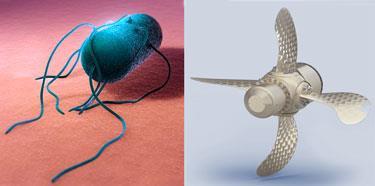Nanowires that can be moved by a magnetic field could be used to deliver drugs in the body
US researchers have made nanowires that can be propelled through liquids with an external magnetic field. The wires could be used to deliver drugs in the human body.
Eric Lauga and Joseph Wang from the University of California San Diego and colleagues made the nanoswimmers by attaching nickel heads to silver tails. They used a magnetic field to propel the wires through human serum, which means that they have potential for use in biomedical applications, such as targeted drug delivery, as no chemicals or fuel sources are required.

The team found that the flexible wires move with a speed approaching that of natural microscopic swimmers, such as the bacteria Escherichia coli. Most importantly, they have a higher dimensionless propulsion speed - body lengths travelled per revolution - than other externally-powered nanomotors such as helical propellers inspired by the flagella of bacteria.
Lauga and Wang now aim to start ’addressing fundamental problems relevant to drug delivery, in particular how efficient the swimmers are for towing cargo in biofluids’. They add that a future challenge will be to investigate how the wires behave when subjected to external flows, such as blood, in the body.
’The work does show that a rotating magnetic field is capable of aligning and propelling these devices remotely, but how this would then be linked with the delivery of a chemical or physical payload is not clear,’ says Jonathan Howse, an expert on nanomachines and nanoswimmers at the University of Sheffield, UK. ’However, this is one significant step towards this goal.’
Serin Dabb
Link to journal article
High-speed propulsion of flexible nanowire motors: Theory and experimentsOn Shun Pak, Wei Gao, Joseph Wang and Eric Lauga,?Soft Matter, 2011, 7, 8169DOI:10.1039/c1sm05503h






No comments yet